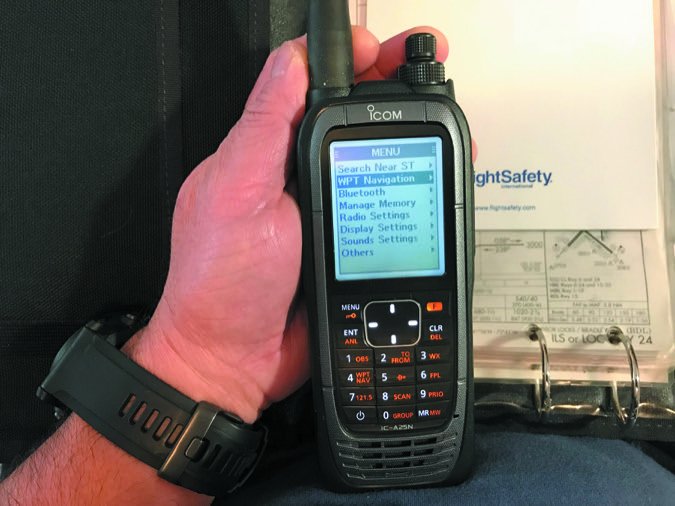In previous Aviation Consumer evaluations, Icom’s A22 portable comm transceiver got high marks for durability, reliability and ease of use. After nearly a decade of use and abuse, a vintage A22 soldiers on in our own flight bag.
We like the Icom portables in part because a radio used for emergency backup should be easy to use in a pinch. Plus, it must have a simple feature set when used as a primary radio in lesser equipped aircraft.
So when we saw the list of gee-whiz features packed into the new A25N (a model that replaces the utilitarian A22)—we wondered if Icom ruined a good thing. To find out, we ordered the flagship A25N for a close look. Worth noting is Icom also offers the A25C, a stripped-down comm-only model. Here’s a field report.
Size and Power Matters

Portable transceivers need to be easy to manage with one hand, small enough to stash in a map pocket and the keys and controls need to be friendly for fat fingers. In our view, Icom nailed the ergos with the A25.
Weighing 13.6 ounces with the rechargeable lithium ion battery and whip antenna attached, the waterproof radio’s chassis measures 5.8 inches high, 2.3 inches wide and 1.3 inches deep. You’ll have to remove the long antenna to fit the A25 into a dedicated radio pocket of a flight tote, but we think the A25 is just the right size. The keys and knobs are signature Icom, which is to say they have a high-quality, rugged feel.
The A25 comes standard with an AC charging/power adapter (it doesn’t use a USB cable) and charging time is roughly three hours. There’s a convenient drop-in charging base as standard and also an optional cigar lighter plug. With lots of users switching to USB panel power (either hard mounted or with an adapter), we wish the A25 had a USB charging option. Battery endurance is listed at roughly 10 hours, but expect less when transmitting. Current draw during transmit is less than 1.8 amps. Still, we think that’s impressive endurance. There’s an optional battery case that accommodates six AA alkaline batteries.
Icom increased the transmit power output in the new A25 to 6 watts, compared to 5 watts in the old A22—which was already a decent performer. But the key to a transmitter’s range isn’t just about power output. It’s the antenna that makes the difference between reliable communications at altitude and when using the radio around terrain, especially inside the cabin. What we’re getting at is don’t always expect the same performance as you’d get from a panel-mounted radio that’s connected to an external antenna system.
The rubber antenna, which uses a quick-disconnect BNC connector, can be removed and the radio can be connected with a dedicated external antenna. If the aircraft is torn open for an avionics upgrade, consider installing a dedicated comm antenna on the aircraft’s belly. The shop might run a length of coaxial cable into the cabin and coil it up in a map pocket or other convenient location, or take it one step further and install a panel jack for plug-in. Frankly, we think it’s worth the investment.
The radio comes with a headset adapter (you supply the push-to-talk switch, though), plus the set generates transmit sidetone like a panel radio. Without the switch, simply key the PTT on the side of the radio, speak into the built-in microphone and listen to the audio through the headphones.
Using It
The A25 has a large 2.3-inch LCD display, which has both a day and night mode. Sunlight readability is good and the screen won’t kill your night vision in a dark cockpit.
The set has a useful battery status indicator for both the standard lithium ion pack and for the optional alkaline pack. It uses a simple graphic to show the charge status and also confirms the battery is charging.
Setting the desired frequency should be an easy affair and on the A25 it is. You can set the active frequency with the keypad or use the rotary dial at the top of the case. So you don’t inadvertently tune it off frequency, you have to press the Function key, plus the keypad has a lock. The set also has a squelch level adjustment, and a dedicated onscreen squelch graphic shows the level that’s set. One feature we like with the company’s panel radio is the ANL, for automatic noise limiter, and it’s standard in the portable. This helps clean up noise (engine ignition, for example) that might sneak into the comm receiver. When the receiver has a signal, RX is displayed. For emergencies, there’s a dedicated one-touch 121.5 MHz key. Actually, it’s two-touch because you have to hit the Function key to activate it. There’s also a 300-channel/15-group storage memory bank, and you can name channels and assign them a type. This includes GND, CLR, APP and other comm and nav acronyms.
The transceiver also stores the previously selected frequencies. This is accessed with the Recall CH key, which sets the frequency after you select which one you want. This might be useful for fetching an updated ATIS when returning to the airport or quickly tuning back to tower or UNICOM frequency. The frequency storage bank is easily accessed with the MR (memory) key.
The A25’s VFO scanning function sweeps every frequency on the 108.000 to 136.9917 MHz band, while a priority watch feature looks for and locks in the signal on a programmed priority channel.

If you still navigate with VORs, the A25N has a navigation receiver. When the nav band frequency is in use, the set displays a CDI screen with a basic compass rose, CDI, OBS value indicator, the heading to or from the VOR station and a TO/FROM indicator. The nav functions are accessed via the keypad by pressing the Function key and then the corresponding nav function on the 1,2,4,5 and 6 function keys.
We understand that Icom is trying to make this a full-featured navcomm of sorts, but we wonder how many pilots will make use of the old-school VOR feature. There’s no glideslope receiver, as Sporty’s builds into its SP400. It performed favorably when we reviewed it in the October 2014 issue of Aviation Consumer, in addition to the Yaesu Pro-X. Both are still offered.
What would seem more useful is GPS navigation and the A25N has it with an internal GPS/GLONASS receiver. But, we’re disappointed that its functionality is shortchanged without an internal database. We dinged Yaesu’s Pro-X portable for the same reason.
Icon takes the nav interface to a higher level with the RS-AERO1 app. With it you can build flight plans based on lat/long coordinates and then export the data to the A25N via Bluetooth for navigating. The radio’s display shows estimated time enroute, speed over the ground, distance to destination and display range. It also stores waypoints in memory and saves transferred flight plans previously built on the app and sent over via Bluetooth, plus you can edit and delete them in the radio’s Manage FPL menu. There’s no topo map on the radio, but there is in the RS-AERO1 app.
One useful advantage is being able to add a point by touching its location on the app’s map page and navigating direct to it with the radio. Maybe you’re flying floats or skis and want to mark some play areas. It works, but we’d like to see this expanded with other mainstream apps that might add to the utility. There’s also a search function for nearby ground navigation stations that have GPS position.

This is Icom’s first stab at this advanced tech (frankly, it’s expected on a radio in the over-$500 price point) and we think the Bluetooth in the new A25N is a good start.
The specs say the Bluetooth has a 33-foot communication range and that’s plenty of performance for even the largest of cabins. To pair, push Menu and select Bluetooth Set from the Settings submenu and Enter. The radio paired easily with our newer iPhone.
The A25N also has 10 preset weather channels for receiving broadcasts from NOAA. The receiver automatically detects a weather alert tone on the selected weather channel, or while the unit is in scan mode. When an alert is received, the display alternately flashes WX and ALT. Accessing the weather mode is easy. Simply push the Function key and then the WX key.
SLIM Competition
We think the A25N will easily survive at the top of the portable transceiver market. The closest and really only competitor with this many advanced features is the Yaesu Pro-X. After using both, we prefer the Icom’s feature set and overall performance.
On the other hand, we wonder how many pilots will make use of all its features. Many we’ve surveyed attest to only wanting easy, reliable communications without having to navigate a deep menu structure, or dance around other supplemental features.
Still, there’s only a $100 price delta between the $450 comm-only A25C and the A25N, which sells for $550. We think the flagship model’s Bluetooth and app compatibility leaves room for future growth—something you’ll sacrifice with the stark (by comparison) A25C.
Icom offers a variety of optional accessories including a remote antenna, a rapid battery charger, belt hangers and also the VS-3 Bluetooth headset (these are earplugs) with push-to-talk switch, which we didn’t evaluate. The RS-AERO1 app for iOS and Android is free.
Contact www.icomamerica.com, 800-872-4266 in Kirkland, Washington. Our thanks to Sporty’s (www.sportys.com) for providing the demo.


